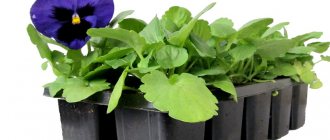Author: Elena N. https://floristics.info/ru/index.php?option=com_contact&view=contact&id=19 Category: Garden plants Published: January 26, 2019Last edits: January 20, 2021
- Soil preparation
- How to care
- Wood mallow (Malva sylvestris)
- Musk mallow (Malva moschata)
It's drizzling endlessly. Only the hollyhocks shine, as if there is a cloudless day above them. Basho
Malva is a beauty that you can’t hide behind a fence! And why? After all, this is definitely not why breeders worked so hard on flowers of jewelery beauty in all possible shades: from virgin white to blue-black! Did you know that the closest relatives of mallow are kalachiki (wortwort) and marshmallow? From the first, the hollyhock inherited unpretentiousness and pretty rounded leaves, and from the second – many healing and even magical properties! It is believed that mallow planted along the fence protects the house and all its inhabitants from the evil eye and evil. But it turns out that not all hollyhocks will do well near any fence... How to please a hollyhock so that it blooms for 4 months in a row, read on.
Planting and caring for mallow
- Planting: sowing seeds in May-June in open ground or in January-February for seedlings (planting seedlings in the ground - in mid-May).
- Flowering: mid-summer.
- Lighting: bright sunlight, light partial shade.
- Soil: rich in humus, well-drained, average moisture, neutral.
- Watering: moderate to abundant, regular.
- Garter: recommended, especially for tall varieties.
- Fertilizing: before budding with complex mineral fertilizer with a predominance of nitrogen.
- Reproduction: seed.
- Pests: slugs.
- Diseases: rust, powdery mildew.
Read more about growing mallow below.
Mallow (lat. Malva) , or mallow , or kalachik , or hollyhock , is a type genus of the Malvaceae family - a herbaceous plant, usually annual, sometimes biennial and perennial. Today, about 30 species of mallow grow naturally in the temperate climates of North Africa, North America, Asia and Europe. Mallow was cultivated in Ancient Egypt and Ancient Greece: a description of the healing properties of the plant was found in the works of Hippocrates and Pliny the Elder. In the twenties of the last century, scientists discovered ecological plasticity and high feeding qualities in mallow. And large bright pink flowers have always aroused the admiration of artists who depicted them in paintings and poets who sang them in poetry. And how can one imagine a Ukrainian hut without a mallow growing next to it in the front garden? Or a Ukrainian towel without its bright pink flowers...
Answers to frequently asked questions
Why are the seedlings not friendly, some of the seeds have sprouted, others continue to sprout?
The problem is a poorly prepared soil mixture. It needed to be steamed and the seeds soaked. In addition, seedlings need warmth.
Why do seedlings droop and fall?
This happens due to thickening. Young sprouts fight for a place under the sun (or lamp). The cause is eliminated by thinning, but the stems are not pulled out, but pinched at the soil level.
Why do the sprouts stretch out?
They become thinner and lean to the sides. The reason is insufficient lighting, too warm a room and waterlogging of the soil. To correct the situation, the seedlings are switched to infrequent watering (once every 3-4 days) and make sure that the water is warm (from +18 to +20°C).
Why do mallow seedlings wither and die?
Due to the dry soil, they receive little moisture. Wilting begins with the lower pair of leaves. Their curling indicates the presence of fungal spores or pests.
The main thing is to notice the disorder, eliminate the cause in time and provide the flowers with proper care. And they will reward you with beauty that is pleasing to the eye.
Botanical description
The most famous and ancient representative of the genus woodland mallow is a plant with a straight, recumbent or ascending stem 30-120 cm high, at first fluffy and hairy, and then bare. The leaves of the mallow are heart-shaped, round, notched or five-seven-lobed, pubescent, petiolate. Large, up to 12 cm in diameter, flowers in the shape of a wide bell with characteristic purple stripes of 1-5 pieces are hidden in the axils of the leaves. In some species, the inflorescences form racemes.
Mallow blooms from June to August, it is frost-resistant, drought-resistant and easy to care for.
- Gardening work in November - 9 points that will preserve your garden until spring
Depending on the variety, single or double flowers vary in color from almost black to white. Petals are oblong, obovate, deeply notched. The mallow root is spindle-shaped, branched, and long. The fruit is polyspermous; the seeds remain viable for 2-3 years.
Advice from experienced summer residents
The herbaceous perennial is easy to care for, but when growing it, experienced gardeners recommend paying attention to:
- Moderate watering on not very dense soil, preferably light loam with a neutral pH.
- Avoid shaded beds. Lack of light threatens the loss of decorativeness.
- Planting in windy areas is prohibited.
- Mandatory shelter when cold weather sets in.
- Replantation is not advisable. Mallow has difficulty coping with trauma to the root system and stress. When planting seedlings, it is better to use peat cups.
- Mallows open up new possibilities in landscape design. Plants are suitable for decorating a garden plot in a country style and for creating separate zones. Great for group plantings.
Perennial mallow will decorate any front garden. In the old year 2022, gardeners are thinking about and planning flower plantings for next year. High-quality mallow seeds will add elegance and elegance to your garden plot. Landings according to the lunar calendar will help your dream come true.
5 3 votes
Article rating
Growing mallow from seeds
Growing conditions
If you don’t want to make extra efforts and are in no hurry to see the mallow blooming this year, you can sow the seeds directly into the ground in May or June. But then your mallow will only have time to form a rosette of leaves before the onset of winter, and will bloom only next year. If you want the mallow to bloom this summer, you should sow seeds for seedlings in January-February.
But even if you are ready to grow mallow as a biennial or perennial plant, the seedling method is still more reliable than the seed method.
For both annual and perennial mallow, this process is the same, the only difference is when to sow. Annual mallow is sown in mid-winter, planted in the ground in May, and blooms in mid-summer. Biennial and perennial mallow is sown in May and planted in the ground in August or September.
Growing seedlings
It is advisable to soak mallow seeds that you have stored for a year or two or purchased at a flower shop for 12 hours in warm (45 ºC) water before planting in order to soften the hard seed shell and facilitate the germination process.
It must be said that mallow seeds, which remain viable for up to three years, germinate much better in the third year of storage than in the first two years.
To sow mallow for seedlings, it is better to use peat pots, since the roots of the mallow do not tolerate transplantation well and often do not take root in a new place. The temperature for seed germination should be 18-22 ºC, then seedlings will appear in two weeks. If you sowed mallow in a container, then after three leaves appear on the seedlings, you will have to thin them out so that there is a distance of 2-3 cm between the seedlings. The removed sprouts can be saved by carefully planting them in peat pots. When the seedlings grow and become stronger, they need to be hardened off by placing them in fresh, cool air for several hours. In May-June, seedlings can be planted in the ground directly in pots.
In the photo: Growing mallow seedlings from seeds
The easiest way to reproduce
Typically, gardeners remove the mallow inflorescences when it has finished blooming. If you don’t want to sow in the ground or grow seedlings, you can leave a few flower stalks so that the seeds can be sown. Only the strongest plants will sprout in spring. They can be used by transplanting them to the right place as soon as they form a second true leaf. Such plants will bloom in the year of planting. This method is not suitable only for double flowers. Seedlings obtained as a result of self-seeding usually do not retain terry.
Planting mallow
Soil preparation
Choose a sunny area in the garden (mallow grows in partial shade, but loses its bright color and stem height) with good drainage and loose loamy, humus-rich soil. The place for sowing should be high to prevent rotting of the roots from standing melt water. It would be nice if the area was protected from winds and drafts. It is best to plant mallow along the fence: there will be a support nearby to which you can tie the stems. If your soil is poor, you will have to fertilize it by mulching the area with humus. But more on that later.
How to plant in the garden
Seedlings of annual mallow are planted in open ground in mid-May. Seedlings of two-year or perennial mallow are planted in the ground in August-September. Seeds of biennial and perennial mallow can be sown directly into the ground. This is done in the spring, in April-May, after late frosts. Small holes are made in the soil up to 3 cm deep and 2-3 seeds are placed in each hole.
Depending on what variety of mallow you are planting, the distance between seedlings should be from 25 cm to 50 cm.
The hole is filled in, the soil is pressed down and moistened. If you are not sure that summer has finally arrived, place covering material on your bed so that the sprouts are not damaged by possible frosts. Under favorable weather conditions, the seedlings will hatch in two weeks. When the seedlings have 3-4 leaves, they need to be thinned out, leaving one tall seedling in the hole.
Planting hibiscus in the garden - all the information you need
Application in garden design
The use of mallow in garden design is so wide that it can be considered irreplaceable.
It is used:
- along hedges, walls, fences;
- in the background of any flower arrangement;
- for framing entrance groups, gates;
- on mixborders;
- as borders;
- in bouquet planting;
- in soliter planting;
- to divide the space into zones, in combination with other tall plants, such as sunflowers.
Garden decor
Mallow care
How to care
Growing mallow is a simple process, since mallow is not a fussy plant. Regular moderate watering, especially in dry summers, loosening the soil and weeding, timely removal of wilted flowers are mandatory requirements for caring for mallow.
- How to sow perennial chrysanthemum seedlings
In addition, it would be good to feed the plant before budding with mineral fertilizers with a predominance of nitrogen.
A tall mallow needs staking to prevent it from breaking under strong gusts of wind, so plant it along the fence or dig in high pegs to secure the plant. Well, if you want to make a perennial from an annual, immediately after the mallow has bloomed, cut off all the flower stalks so that the seeds do not have time to set. That's all for caring for mallow.
In the photo: Mallow flowering in the garden
Diseases and pests
Mallow is attacked by slugs. They are collected by hand: place small bowls in different places, pour beer into them, and after a day, walk around and collect the slugs that come crawling to get drunk.
Of the few diseases that affect mallow, the worst is rust, which can easily be contracted near metal fences. The disease manifests itself in the appearance of dark red spots on the back of the leaves. Affected leaves should be removed and burned.
Sometimes powdery mildew appears on mallow. You can fight it with a solution of colloidal sulfur or a specialized fungicide.
In the photo: Pests of mallow on a flower
Mallow after flowering
In the fall, after the mallow has bloomed, the stems are cut down to ground level. At the same time, you can fertilize the soil by mulching it with humus and compost at the rate of 3-4 kg per 1 m2. Mallow should overwinter under cover of spruce branches, fallen leaves or straw.
In the photo: Mallow has bloomed
Choosing a suitable location
Over time, you will have to plant the seedlings outside. And to do this, you need to decide in advance where exactly the mallow will grow.
For planting, it is better to choose a place that is clearly visible from anywhere in the yard. What's the point of a beautiful plant if you can't really see it? It is worth remembering that generally mallow has rather long stems - more than a meter. A gust of strong wind may well break it. To prevent this from happening, it is advisable to either protect the plant from the wind or install a special fence to support the stems. But the easiest way is to plant mallow near the fence so that the wind does not cause unnecessary trouble.
In this case, it is best to plant flowers on the south side of the fence or at least on the west side. Then the plant will receive a lot of sunny color - this is very important for mallow. And protection from cold winds from the north and east will not be superfluous, especially in the first stages of life, while the plant is not strong enough. If the mallow does not receive enough light, then the flowers on it will not be too bright, which is unlikely to please the gardener.
The healing properties of mallow
Mallow has long been known in folk medicine. The beneficial properties of mallow have been studied by healers in many countries. For example, an infusion of mallow flowers and leaves treats inflammation of the stomach and intestinal disorders. Hot baths with steamed leaves or flowers of mallow (wood mallow) help relieve swelling of the spleen. The wild mallow herb is a constant component of breast collections.
Lavatera: planting and caring - a relative of mallow
In the form of lotions and compresses, a decoction of mallow flowers is used for skin diseases to relieve itching and to heal wounds (obviously, due to the mucus contained in mallow). Mallow is also used in medical cosmetology to restore the epidermis and prevent pustular rashes. Preference in folk medicine is given to mallow flowers, since they contain higher levels of sugars, vitamin C and carotene than the leaves. The main thing is that preparations from mallow do not give unwanted side effects and have no contraindications.
Beneficial properties of mallow:
- expectorant;
- emollient;
- reparative;
- enveloping;
- anti-inflammatory;
- restorative.
Mallow tea for coughs: pour 2 teaspoons of finely chopped flowers (or leaves) into a glass of boiling water and leave for 10 minutes, strain, drink 2-3 cups a day. You can add honey, but then the tea should be no warmer than 40 ºC.
… Every year in May, Kyoto’s Kamigamo Temple and the city host the Aoi Matsuri festival, dedicated to mallow. People put on bright clothes and walk through the streets of the city dancing and singing. This holiday is many centuries old...
The May rain is endless... The hollyhocks are reaching somewhere, Looking for the path of the sun. Basho
When will the shoots appear?
Under favorable conditions, mallow seeds hatch quickly. Shoots appear in 8-12 days. When all the seeds have sprouted, the film is gradually removed from the box. On the first day, the container is released from cover for 1 hour, on the second - for 2 hours. From the third day the film is removed completely. Further development of plants will occur at room temperature without additional insulation.
Types and varieties of mallow
The genus mallow in cultivation includes about 60 species of ornamental plants. The ancestor of this genus, woodland mallow, is an annual plant. And species such as Sudanese mallow, hybrid, musky and wrinkled are predominantly perennials. True, it must be said that not all flower growers include all these species in the mallow genus, considering, for example, that the Sudanese mallow, or hibiscus, as well as the wrinkled mallow, or rose hollyhock, although they belong to the mallow family, are related to to another kind. Let’s not quibble: the plants are so similar in characteristics that it makes sense to combine them into one section on care and cultivation.
Where is the best place to plant flowers?
Picturesque flowers grow well in flower beds and look great as a hedge. They are planted mainly in groups in the garden. Ridges exposed to the winds are not suitable for hollyhocks.
Tall stems need support. They require tying, otherwise they may break in gusts of wind. It’s good if it is possible to secure the hollyhocks on stakes.
Ideally, hollyhocks are planted in an area along fences. The fence performs a 2 in 1 function: it defines the territory and is used as a trellis for tall hollyhocks. There is an opinion that it is contraindicated for hollyhocks to be near a metal fence due to rust damage. But this is a myth: the underside of the leaves is occupied by the fungus that causes the disease.
Mallow annual
Wood mallow (Malva sylvestris)
So, forest mallow , or Kalachiki . This biennial plant is grown in our country as an annual one. It grows up to 120 cm, its flowers are characterized by the presence of darker veins than the color of the flower. Popular varieties are mallow zebrina, characterized by large flowers of soft pink color with dark red veins. The Black Mother of Pearl variety is also in demand - dark purple flowers up to 7 cm in diameter with black veins.
In the photo: Wood mallow or kalachiki
Conditions for crops
The box with the crops is covered with a transparent film. In greenhouse conditions, the seeds will hatch faster. The covering material is removed every day for 10-15 minutes. This is necessary to ventilate the mini-greenhouse.
Condensation forms on the walls of the container and the film. It must be wiped with a dry cloth to avoid the appearance of putrefactive microorganisms. Otherwise, all crops may die.
perennial mallow
Musk mallow (Malva moschata)
It is a low perennial - no higher than a meter. The fragrant flowers of white or pink musk mallow reach a diameter of 5 cm. This mallow is sometimes called nutmeg mallow. Popular varieties are White Tower and Pink Tower, 70cm tall with snow-white or hot pink flowers respectively. These varieties bloom until frost.
- Spiraea Wangutta: planting and care, description of varieties
In the photo: Musk or nutmeg mallow
Sudanese mallow
Or Hibiscus Sabdariffa , or Sudanese rose - a biennial plant grown for its fruits, which have long been one of the components of fruit drinks that have medicinal value. The known bush form is Malva sabdariffa var. Sabdariffa and the tree form Malva sabdariffa var. Altissima.
In the photo: Sudanese mallow or hibiscus sabdariffa or Sudanese rose
Wrinkled mallow (Malva rugosa)
Rose stock , or wrinkled alcea - it is conventionally called mallow. The plant in nature reaches two meters in height, its flowers are 3 cm in diameter, yellow. It is a perennial. Garden form - pink hollyhock, or rose hollyhock (Malva alcea). The plant is a perennial, reaches 90 cm in height. It has varieties with both simple and semi-double and double flowers, similar to peonies.
For example, the Chater's Double Strein variety is a double mallow with large flowers of different colors, while Single Mixed has simple flowers reminiscent of hibiscus. Stock rose varieties also differ in size: the Powder Puffs Mixed variety, for example, reaches a height of two meters, and Majorette Mixed is a dwarf plant (up to 75 cm), but with large semi-double flowers.
In the photo: Rose hollyhock or rugose mallow or rugosa alcea
Hybrid mallow (Malva hybrida)
It is a perennial with several stems, height up to 2 m. The flowers are white or pink, double, very large. Blooms in June-September. Popular varieties: Chaters Double, Gibbortello, Powder Puffs.
In the photo: Hybrid mallow
You should know that almost all varieties of forest mallow are annuals, and varieties of other types of mallow are mainly biennials or perennials, but this division is arbitrary: both among the varieties of forest mallow there are perennial varieties, and among the conventional perennials there are annual varieties.











